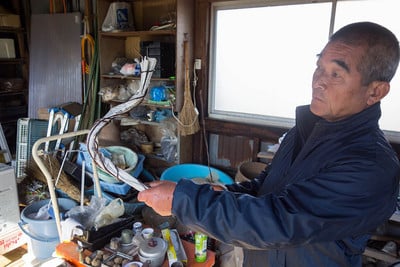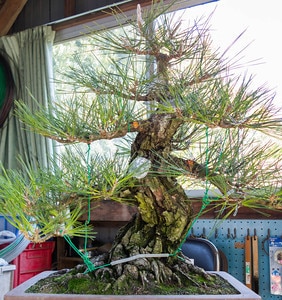Is there a way to determine whether or not my wiring is suitable for creating the bonsai in my mind’s eye? Yes! I learned about it in Mr. Iwakiri’s garden. Iwakiri recommends modeling the trunk line before wiring actual trees. He demonstrated the idea with newspaper and aluminum wire.
The idea is to create a mock-up of candidate trunk bends and then build up the model to the desired thickness of the future trunk to evaluate the success of the initial bends. Many bends look great on skinny trees but look funny or sometimes disappear entirely as the trunk thickens. Iwakiri recommends starting with a simple model, taking a photo of the model, and then adding clay or paper mâché to simulate the girth of the future trunk. The photos come in handy, he says, as it can be hard to remember what the bends look like beneath the clay.

Paper and wire represent the young trunk – the tea bottle is closer to the eventual thickness of the trunk

Mr. Iwakiri considers how to bend the model trunk
Iwakiri has put the technique to good use. Here’s a young tree he’s been developing for 30-40 years. Branch work has begun only recently.

Black pine in development
Subscribe to Bonsai Tonight
New Posts Delivered Every Tuesday and Friday
Adair Martin says
Jonas,
I like your caption: “A young tree he has been developing for 30 to 40 years!” Here in the USA, we expect trees to look like that at the end of the workshop!
Luigi says
Jonas, first of all thank you for your blog. reading your posts I have learned more than reading dozens of books.
Regarding the post I am very courious to know what is the right technique in order to get such big trunk mantaining the lower branches. In other word how to balance the plant resources between the lead branches, to be sacrified, and the lower ones.
Keep up with the good work! Greeting from Italy.
Jonas Dupuich says
Hi Luigi – thanks so much for the note! Your question is great – I have future posts planned on the topic so more info is on the way. In the meantime, I can say the idea is to develop the tree from scratch in a way that preserves branches as the trunk is being developed. Terminal buds can be used for thickening and lateral buds can be used for future branches. Periodically cutting back to lateral branches allows you to change the direction of the trunk and create taper. Here’s the best image I can point you to on the topic: http://www.bssf.org/articles-and-stories/care-of-japanese-black-pine-stages-of-development/ (thanks Eric!).
I hope this helps a bit – feel free to ask additional questions and I’ll keep working towards a better answer.
Jonas
Anny says
Thanks for the article. This is a very interesting technique of growing bonsai. I think this method will help many beginners to grow unusual and beautiful tree.